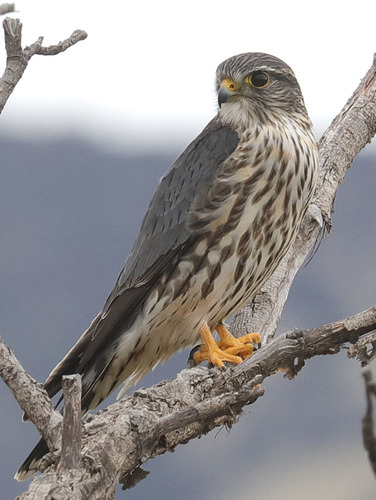
Merlin
The Merlin (*Falco columbarius*) is a small, fierce falcon found across the Northern Hemisphere. Known for its swift flight and aggressive hunting style, it plays a crucial role in controlling populations of small birds and rodents. Historically, Merlins have been used in falconry, admired for their speed and agility. Unlike larger falcons, they often hunt by flying low and fast, surprising their prey. Their adaptability has allowed them to thrive in a variety of habitats, from open grasslands to urban areas.
24-33 cm
Length
50-73 cm
Wingspan
Least Concern
Conservation Status
Distribution
Merlins breed across North America, Europe, and Asia. They are migratory, with northern populations wintering in the southern United States, Central America, South America, the Caribbean, and northern Africa, southern Europe and south Asia. Altitudinal range varies from sea level to treeline.
Lifespan
Up to 12 years in the wild, although average lifespan is likely shorter. Captive birds can live longer.
Merlin's Habitat
Habitat Types
Open Woodlands, Grasslands, Coastal areas, Tundra, Urban environments
Climate Zones
Temperate, Boreal, Subarctic, Arctic
Adaptations
Merlins are highly adaptable to various open habitats. They require areas with sufficient prey availability and suitable nesting sites, which can include cliffs, abandoned nests of other birds, or even buildings in urban areas. Their small size allows them to utilize a wider range of habitats than larger falcons.
Variations
Several subspecies are recognized, differing slightly in size and coloration. For example, *F. c. columbarius* (North American Taiga Merlin) is generally darker than *F. c. richardsonii* (Prairie Merlin).
Appearance
Breeding Plumage
Plumage is generally similar year-round, although fresh plumage after molting may appear more vibrant.
Seasonal Feather Changes
Minimal seasonal variation.
Sex Based Plumage Differences
Males typically have a blue-gray back and wings, while females and juveniles are browner. Underparts are streaked, with variations in color intensity between subspecies.
Notable Features
Sharp, pointed wings typical of falcons., Relatively long tail., Dark 'mustache' stripe below the eye.
Diet and Feeding
Primary Foods
Small birds, Insects, Small rodents, Bats
Foraging Behavior
Merlins are agile hunters, often using low, fast flights to surprise prey. They may also hunt from perches or soar at higher altitudes. They are known for their pursuit flights, chasing down birds in the air.
Specializations
Their speed and maneuverability are key adaptations for catching fast-flying birds. They have strong talons for grasping prey.
Seasonal Diet Variations
Diet can shift depending on prey availability. During migration and winter, they may rely more on small birds, while in the breeding season, insects may form a larger part of the diet.
Behavior
Social Structure
Generally solitary or in pairs, except during migration when they may form small, loose flocks.
Communication
A series of rapid 'ki-ki-ki' calls., Whining calls during courtship., Alarm calls near the nest.
Migration
Many populations are migratory, traveling long distances between breeding and wintering grounds. Migration routes are often along coastlines or mountain ranges.
Territorial or Group Behaviors
Merlins are territorial during the breeding season, defending their nesting area from other raptors and potential predators. They can be aggressive towards intruders.
Conservation
Threats
Habitat loss, Pesticide use (historical impact), Collisions with vehicles and structures, Climate change
Protection Programs
Monitoring of populations, Habitat restoration efforts, Regulations on pesticide use
Local National Laws
Protected under the Migratory Bird Treaty Act in North America and similar legislation in other countries.
Population Trend
Generally increasing or stable.
Population Estimates
Global population estimated to be in the hundreds of thousands.
Interesting Facts
Merlins were historically affected by DDT.
Like other raptors, populations declined due to eggshell thinning caused by the pesticide DDT in the mid-20th century. Populations have recovered since DDT was banned.
They are one of the smallest falcons in North America.
Their small size allows them to specialize in hunting small, agile prey.
Merlins sometimes cache food.
They may hide uneaten prey in crevices or vegetation to retrieve later.
Faqs about Merlin
What is the difference between a Merlin and a Peregrine Falcon?
Merlins are much smaller than Peregrine Falcons. Peregrines have a more distinct 'mustache' stripe and typically hunt by stooping (diving) from great heights, while Merlins often hunt with level pursuit flights.
Are Merlins endangered?
No, Merlins are currently listed as Least Concern by the IUCN. Their populations have recovered well since the banning of DDT.
Do Merlins migrate?
Yes, many populations of Merlins are migratory, traveling long distances between breeding and wintering grounds.
Can I keep a Merlin as a pet
No. It is illegal to keep a Merlin or any bird of prey without special permits, and these birds are not suitable as pets. Consult a professional for expert advice
Copyright @ Nature Style Limited. All Rights Reserved.
 English
English